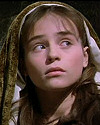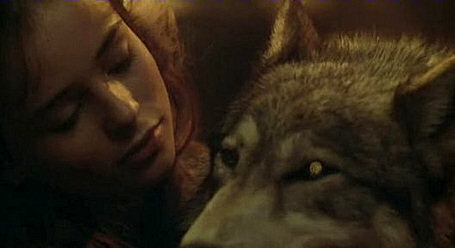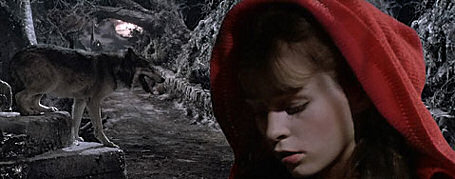Damon Hyldreth
Sculpture
CV
Statement
Projects
Contact
Definitions
Materials
Art Links
Mythologies
Site Map
Sculpture
THE COMPANY OF WOLVES
Cinema
Unlike Disney's neutered, and sugar coated filmic simulacrums of folktales, The 1984 Neil Jordan film, The Company Of Wolves, resembles the original unexpurgated oral folklore of medieval times. These tales, which Marina Warner called: "the television and pornography of their day" (1) were consistent with their times. These were times that were full of pain, conflict, tragedy, and violence as well as the good and beautiful. The film accurately captures the flavor of rustic nightmares, old and fearful, yet faintly familiar and subtly sensuous. In keeping with the original versions of most folktales, the sexual subtext is never far from the surface.
This movie, whose screenplay was adapted by Angela Carter and Neil Jordan from Carter's story of the same name explores Little Red Riding Hood and werewolf themes with a modernist psychological bent. Rather than using the "once upon a time" formula, the film is structured as a dream of the adolescent Rosaleen, a girl curiously yet cautiously creeping from childhood into adulthood. In the beginning of the movie, we see Rosaleen lying dreaming in her bed in her parent's large modern country English home. Her room is filled with toys and dolls that symbolize the childhood that she will soon be leaving. In contrast to the toys, the sleeping Rosaleen is wearing lipstick and rouge with a magazine lying next to her titled "The Shattered Dream". On her door hangs a white chiffon dress symbolizing the path of purity to adulthood for adolescent girls. Her 18-year-old sister Alice seemingly has followed that path as she wears the same white chiffon dress. It is apparent that there is a fierce sibling rivalry between the two sisters and Rosaleen's dream begins with wolves chasing her sister through a dark, dense forest then cornering and killing her.

GORDIAN KNOT
UNCANNY
FIREBIRD
VIXEN
WOLVES
Granny (to Rosaleen):

Granny:
"They say that priests' bastards often turn into wolves as they grow older! If the child is born on Christmas Day, if he's born feet first he'll be the one, if he's born feet first and his eyebrows meet in the middle! Oh yes, very bad! One day he'll meet the Devil in the
wood".
Rosaleen: "That's a horrid story! I didn't like it at
all".
Granny: "It's not a story, child, but God's own truth. So if you should spy on a naked man in the wood, run as if the Devil himself were after you!
Never stray from the path, never eat a windfall apple and never trust a man whose eyebrows meet!" (2)
In the tale "Call of Nature" a young woman marries a "traveling man" (2) and on her wedding night a strange look comes over him and he expresses a desire to take a leak outdoors (where a pack of wolves prowl about). He doesn't come back and the woman remarries "a man not to shy to piss in a pot" (2). Some years and three children later her first husband returns with long hair and the same clothes in which he left (now worn to rags) demanding to be fed. He sees her children, goes into a rage, calls her a whore and transforms into a wolf. Her second husband returns in the nick of time to chop off the wolf's head. The head flies into a milk filled caldron tainting it red. When the severed wolf's head bobs back up to the surface it CVs the form of the man's head. Similar tales occur throughout the film. When the townspeople trap and kill the wolf that killed Rosaleen's sister Alice, Rosaleen's father brings home the wolf's severed forepaw as a prize:
Father:
"When I cut it with the knife it was a forepaw, I swear, of a grizzled giant wolf…and then before my very eyes"…He unwraps the bundle. Mother gasps and clutches Rosaleen.
It is a severed man's hand, with a large ring on one finger. (2)
Rosaleen's mother acts as a compassionate counterpoint to her Grandmother and she tells Rosaleen: "You pay too much attention to your Granny. She knows a lot, but she doesn't know everything. And if there's a beast in men, it meets its match in women too. Understand me?"(2) Rosaleen responds to these tales and experiences of wolves by stories of her own creation that depict wolves and werewolves in a compassionate manner such as her story of a wounded girl werewolf who is cared for by the old priest in her village. Rosaleen illustrates her independence and questioning of the status quo in this response to her Grandmother concerning her sister being killed by wolves: "Granny: Your only sister, all alone in the wood, and nobody there to save her! Rosaleen: "Why couldn't she save herself?"(2) Rosaleen is no fool and in the end of the movie she does just that, though not in the way one would think.
These stories illustrate the theme of the movie, which is one of Rosaleen's passage from childhood and innocence into womanhood and knowledge. Rosaleen's transition is highlighted in a scene when she climbs high into tree in the woods. There she finds a stork's nest (an ancient symbol of fertility and human birth), which contains feathers, four gray eggs and a hand mirror and a small jar. Rosaleen opens the small jar, which contains rouge. She dips her index finger into it and rubs it onto her lips. Then she looks at her reflection in the hand mirror and as she does, the eggs one by one crack and open, revealing a tiny figurine of a man inside each one.

She reaches forward and takes one of the glistening little figures, putting it in her pocket. As Rosaleen walks back home through the woods she passes by a large wolf sitting above her on knoll. As she walks admiring the tiny little figurine in her hand she seems immune to the wolf. When she returns home, she shows the figurine to her mother and we see a close up of the figurine, a tiny tear dripping from one eye. Rosaleen's seeing herself in the mirror as a woman and retrieving the tiny figurine of a man symbolizes that she has the awareness of herself as a woman with power to give birth, birth not only to a child but to her own adult self.
The final chapter of The Company Of Wolves is Rosaleen's journey through the forest to grandmother's house. "Don't stray from the path," Rosaleen is told, again and again, and the path is both literal and figurative: the path through the forest and the path of life. Staying on the path is the conventional approach but Rosaleen is not afraid to explore what goes on when you leave the path as described in Carter's original story:
She stands and moves within the invisible pentacle of her own virginity. She is an unbroken egg; she is a sealed vessel; she has inside her a magic space the entrance to which is shut tight with a plug of membrane; she is a closed system; she does not know how to shiver. She has her knife and she is afraid of nothing. (3)

As in Perrault's version of Little Red Riding Hood, Rosaleen meets a werewolf disguised as a Huntsman on the way to Grandma's house. They make a bet as to who will reach Grandma's house first. The Huntsman arrives first and kills Grandma. Rosaleen arrives and realizes what has happened, but clever girl that she is; she gets the drop on the Huntsman/wolf with his own rifle. Then comes the classic exchange: Rosaleen: "My, what big arms you have". Huntsman: "The better to hug you with." (2) The Huntsman then reminds Rosaleen that he won their bet and that she must pay him with a kiss. As they kiss Rosaleen suddenly pushes him away saying: "Jesus, what big teeth you have!" (2) The Huntsman answers: "All the better to eat you with." (2) and Rosaleen promptly grabs his rifle and shoots him. He falls to the floor howling and writhing in pain and transforms into a wolf. He doesn't attack her but instead sits whimpering on the floor like a cowered dog. Rosaleen says: "I never knew a wolf could cry" (2) and moves over beside the gray wolf sitting on the hearth and hugs it, kissing and cradling it tenderly. We see his fellow wolves that are outside leave.
Rosaleen:
"Leaving you, are they? You'll be all alone.
I'll tell you a story of a wounded wolf. . .
for she was just a girl after all. . .
who had strayed from the path in the forest. . .
and remembered what she'd found
there". (2)

As Rosaleen tells her story, we see a white rose in full bloom slowly opening. As it opens it begins to turn deep red turning completely red when fully open. Rosaleen's transition is complete; she has found her man and domesticated the beast within him.
The next morning when Rosaleen's parents and the villagers come to rescue her, she is now a wolf and she leaps past her parents through the shattered window of her Grandmother's house and runs off with her mate. Rosaleen has embraced love, tamed the beast in the Huntsman, and chosen to follow her mate. The two wolves run together through the woods where they leap over a doll's house in the path. They leap over Rosaleen's now life size sailor doll and her now life size life size teddy bear, knocking its head off. We are suddenly in present day and we see Rosaleen sleeping in her room in her parent's large country English home. The two wolves are now a pack and enter the front door as Rosaleen's dream intersects her life. The wolves run up the stairs to Rosaleen's room and from outside a wolf bursts through Rosaleen's window into her room destroying her toys. This mirrors her leap (as a wolf) through the shattered window of her Grandmother's house in her dream indicating that the symbolic elements of her dream have entered the reality of her life. .
As in Freud's analysis of dreams, Rosaleen's dream deals with her inner conflicts portraying elements of her psyche as characters in her dream. In Rosaleen's dream, her Grandmother symbolizes the path of rules, caution, and fear. In her dream Rosaleen is warned by her Grandmother to never "stray from the path… Once you stray from the path you're lost entirely! The wild beasts know no mercy. They wait for us in the wood, in the shadow, and once you put a foot wrong they pounce!" (2) What the Grandmother is really saying is to stay on the path of celibate adolescence leading to marriage and to beware of the bestial sexuality of men: "Oh, they're nice as pie until they've had their way with you. But once the bloom is gone, oh, the beast comes out." (2)
Rosaleen's father is her protector, a man who has tamed the beast within himself. He tells Rosaleen (indicating his rifle) "This is all these beasts understand." (2) Rosaleen's mother understands of the nature of sexuality between men and women: "…if there's a beast in men, it meets its match in women too." (2) Rosaleen shows that she has understood and mastered the task of the taming of the beast in man, symbolized by the wolf aspect of the Huntsman. When Rosaleen says to the Huntsman "My, what big arms you have." (2) and his reply is one of love:" The better to hug you with." (2), she offers affection in the form of a kiss. When his reply to her question about the size of his teeth is met with an aggressive reply: "All the better to eat you with." (2), Rosaleen shows that she has taken her father's advice to heart and promptly shoots him. She rewards love with love and aggression with even firmer force. When the wolf emerges from the Huntsman, and Rosaleen hugs and pets it, it whimpers like a good domesticated dog and it's wild companions outside leave, sensing that it has left their kind and gone over to the human, domestic side.
- Damon Hyldreth

1 Marina Warner, From the Beast to the Blonde: On Fairytales and Their Tellers. London: Chatto, 1994., page xiv
2 Angela Carter and Neil Jordan (script), 1984 The Company of Wolves
3 Angela Carter Burning Your Boats The Collected Short Stories, “The Company of Wolves”, Penguin Books, 1995, page 215
4 ibid. page 212
New York Times Review: The Company of Wolves
James Rose, The Dreaming and The Dreamt, A Lexicon of Neil Jordan’s The Company of Wolves
DamonArt@gmail.com